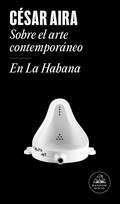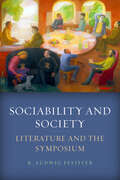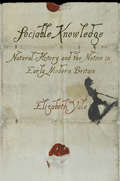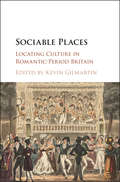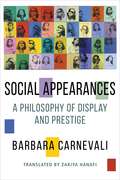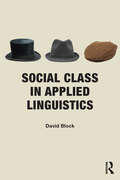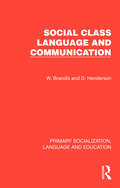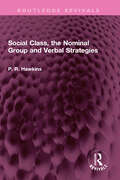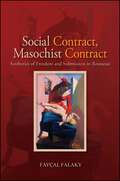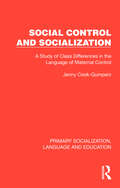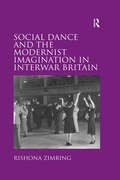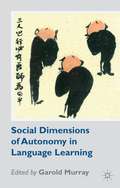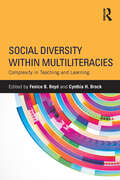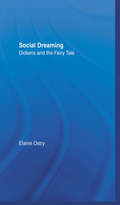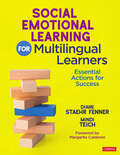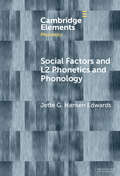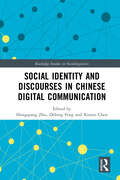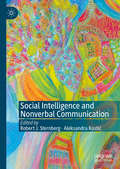- Table View
- List View
Sobre el arte contemporáneo / En La Habana
by César AiraPremio Formentor 2021 Dos lúcidos y locuaces ensayos que abordan el proceso de creación artística en el campo de la literatura y de las artes visuales, así como el lenguaje que se esconde detrás de las piezas de museo. Premio Iberoamericano de Narrativa Manuel Rojas 2016. Los dos ensayos que integran este volumen fueron escritos con una década de diferencia. Sobre el arte contemporáneo es la alocución con la que César Aira inauguró el congreso Artescritura, que tuvo lugar en Madrid en 2010 y que se proponía como objetivo superar la brecha que separa a escritores y a artistas visuales. En La Habana, en cambio, parte de un recorrido por la casa museo del escritor Lezama Lima, realizado durante una visita a Cuba en el año 2000, y desemboca en una crónica del viaje por los museos de la ciudad y los objetos que allí se exponen. Estos dos imponentes textos de uno de los autores clave de las letras hispanas vuelven a incidir en algunos de los temas predilectos de Aira: la relación entre arte y literatura, el proceso de creación, el arte de lo incompleto y, en definitiva, la veracidad de la escritura.
Sobre el estilo tardío: Música y literatura a contracorriente
by Edward W. Said¿Cómo influye el ocaso vital en la obra de un artista? La elegiaca obra póstuma del maestro de los estudios culturales. La crítica suele dedicar mayor atención a la madurez de los creadores, cuando se da por supuesto que florecen sus obras maestras, pero en este extraordinario ensayo Said se adentra en las últimas obras de sus autores más admirados, huyendo, una vez más, de los caminos trillados y buscando respuestas en los lugares menos comunes. Partiendo de algunos escritos de Adorno, Sobre el estilo tardío examina las obras de senectud de grandes artistas de la historia. Algunas suponen la continuidad y resolución armónica del trabajo de su autor durante las décadas anteriores -como en Shakespeare, Sófocles o Verdi-, pero otras, cuyo estudio es más apasionante, abundan en contradicciones, ganan en complejidad y desasosiego, y convierten al autor en un exiliado dentro de su propia obra; en vanguardia incomprendida de su tiempo y punto de partida para las siguientes generaciones, como es el caso de Ibsen, Beethoven, Thomas Mann o Rembrandt. La agudeza y profundidad de las observaciones de Said se hacen aún más pertinentes si tenemos presente que este era el libro en que trabajaba cuando falleció en 2003. Reseñas:«Elegante, desasosegado, inquisitivo y sabio... la elegiaca obra maestra del estilo tardío de Said.»Financial Times «Lo que Said representa -inteligencia crítica, alta cultura y conservación del lenguaje- debería situarse en el centro de nuestras vidas. Este libro es el mejor monumento a su vida y su obra.»Hanif Kureishi «El último libro de Said es una serie de brillantes estudios que analizan la idea de estilo tardío en una galería de compositores, escritores y artistas.»London Review of Books
Sobre héroes y víctimas: Ensayos para superar la memoria del conflicto armado
by JUAN CARLOS UBILLUZEnsayos sobre tres obras literarias que desmontan las bases afectivas y teóricas del giro ético La caída del muro Berlín produjo en muchos espíritus progresistas un giro de la política radical a la ética humanitaria. Los años de Sendero Luminoso afianzaron en el Perú esta operación, y el cambio de siglo estuvo marcado por el paso de la identificación heroica con la revolución a la creencia de que esta inevitablemente conduce al desastre, y que, por tanto, el progresismo debe limitarse a evitar el dolor de las víctimas. Sobre héroes y víctimas examina esta mutación en el sentir y pensar que rige el grueso de nuestras producciones artísticas, culturales y académicas en torno al conflicto armado. A partir del comentario crítico de Los rendidos de José Carlos Agüero, La sangre de la aurora de Claudia Salazar y Memorias de un soldado desconocido de Lurgio Gavilán, Juan Carlos Ubilluz desmonta las bases afectivas y teóricas del giro ético y señala cómo ellas fungen de posibles obstáculos a una futura política de emancipación. Pero Ubilluz da, además, un paso más allá de la crítica y busca un retorno de la ética a la política mediante una serie de Intervenciones donde se revalora el heroísmo y la utopía, se reclama un arte político que trascienda la denuncia y se señala algunos caminos para una izquierda realmente contemporánea.
Sobre la fotografía
by Susan SontagEl libro más emblemático de una escritora comprometida con los temas más candentes de su tiempo y que cierra con un interrogante: ¿hasta qué punto puede mentir una cámara? Sobre la fotografía, publicado por primera vez en 1973, supuso un trabajo revolucionario en la crítica fotográfica. Con él, Susan Sontag planteó cuestiones ineludibles, en el plano moral y estético, acerca de esta forma artística. Hay fotografías en todas partes; tienen la potestad de impactar, idealizar o seducir, pueden provocar la nostalgia o pueden servir de recordatorio, y se erigen en prueba contra nosotros o en el medio para identificarnos. En estos seis penetrantes capítulos, Sontag se pregunta cómo afecta la omnipresencia de estas imágenes a nuestro modo de ver el mundo, y cómo hemos llegado a depender de ellas para confeccionar las nociones de realidad y autoridad. Reseña:«No hay muchas fotografías que valgan más que mil palabras (de Susan Sontag).»Robert Hughes
Sociability and Society: Literature and the Symposium
by K. Ludwig PfeifferToday, churches, political parties, trade unions, and even national sports teams are no guarantee of social solidarity. At a time when these traditional institutions of social cohesion seem increasingly ill-equipped to defend against the disintegration of sociability, K. Ludwig Pfeiffer encourages us to reflect on the cultural and literary history of social gatherings—from the ancient Athenian symposium to its successor forms throughout Western history. From medieval troubadours to Parisian salons and beyond, Pfeiffer conceptualizes the symposium as an institution of sociability with a central societal function. As such he reinforces a programmatic theoretical move in the sociology of Georg Simmel and builds on theories of social interaction and communication characterized by Max Weber, George Herbert Mead, Jürgen Habermas, Niklas Luhmann, and others. To make his argument, Pfeiffer draws on the work of a range of writers, including Dr. Samuel Johnson and Diderot, Virginia Woolf and Marcel Proust, Dorothy Sayers, Joseph Conrad, and Stieg Larsson. Ultimately, Pfeiffer concludes that if modern societies do not find ways of reinstating elements of the Athenian symposium, especially those relating to its ritualized ease, decency and style of interaction, they will have to cope with increasing violence and decreasing social cohesion.
Sociable Knowledge: Natural History and the Nation in Early Modern Britain (Material Texts)
by Elizabeth YaleWorking with the technologies of pen and paper, scissors and glue, naturalists in early modern England, Scotland, and Wales wrote, revised, and recombined their words, sometimes over a period of many years, before fixing them in printed form. They built up their stocks of papers by sharing these materials through postal and less formal carrier services. They exchanged letters, loose notes, drawings and plans, commonplace books, as well as lengthy treatises, ever-expanding repositories for new knowledge about nature and history as it accumulated through reading, observation, correspondence, and conversation. These textual collections grew alongside cabinets of natural specimens, antiquarian objects, and other curiosities—insects pinned in boxes, leaves and flowers pressed in books, rocks and fossils, ancient coins and amulets, and drafts of stone monuments and inscriptions. The goal of all this collecting and sharing, Elizabeth Yale claims, was to create channels through which naturalists and antiquaries could pool their fragmented knowledge of the hyperlocal and curious into an understanding and representation of Britain as a unified historical and geographical space.Sociable Knowledge pays careful attention to the concrete and the particular: the manuscript almost lost off the back of the mail carrier's cart, the proper ways to package live plants for transport, the kin relationships through which research questionnaires were distributed. The book shows how naturalists used print instruments to garner financing and content from correspondents and how they relied upon research travel—going out into the field—to make and refresh social connections. By moving beyond an easy distinction between print and scribal cultures, Yale reconstructs not just the collaborations of seventeenth-century practitioners who were dispersed across city and country, but also the ways in which the totality of their exchange practices structured early modern scientific knowledge.
Sociable Places
by Kevin GilmartinRanging across literature, theater, history, and the visual arts, this collection of essays by leading scholars in the field explores the range of places where British Romantic-period sociability transpired. The book considers how sociability was shaped by place, by the rooms, buildings, landscapes and seascapes where people gathered to converse, to eat and drink, to work and to find entertainment. At the same time, it is clear that sociability shaped place, both in the deliberate construction and configuration of venues for people to gather, and in the way such gatherings transformed how place was experienced and understood. The essays highlight literary and aesthetic experience but also range through popular entertainment and ordinary forms of labor and leisure.
Social Appearances: A Philosophy of Display and Prestige (Columbia Themes in Philosophy, Social Criticism, and the Arts)
by Barbara CarnevaliPhilosophers have long distinguished between appearance and reality, and the opposition between a supposedly deceptive surface and a more profound truth is deeply rooted in Western culture. At a time of obsession with self-representation, when politics is enmeshed with spectacle and social and economic forces are intensely aestheticized, philosophy remains moored in traditional dichotomies: being versus appearing, interiority versus exteriority, authenticity versus alienation. Might there be more to appearance than meets the eye?In this strikingly original book, Barbara Carnevali offers a philosophical examination of the roles that appearances play in social life. While Western metaphysics and morals have predominantly disdained appearances and expelled them from their domain, Carnevali invites us to look at society, ancient to contemporary, as an aesthetic phenomenon. The ways in which we appear in public and the impressions we make in terms of images, sounds, smells, and sensations are discerned by other people’s senses and assessed according to their taste; this helps shape our ways of being and the world around us. Carnevali shows that an understanding of appearances is necessary to grasp the dynamics of interaction, recognition, and power in which we live—and to avoid being dominated by them. Anchored in philosophy and traversing sociology, art history, literature, and popular culture, Social Appearances develops new theoretical and conceptual tools for today’s most urgent critical tasks.
Social Class in Applied Linguistics
by David BlockIn this ground breaking new book David Block proposes a new working definition of social class in applied linguistics. Traditionally, research on language and identity has focused on aspects such as race, ethnicity, nationality, gender, religion and sexuality. Political economy, and social class, as an identity inscription, have been undervalued. This book argues that increasing socioeconomic inequality, which has come with the consolidation of neoliberal policies and practices worldwide, requires changes in how we think about identity and proposes that social class should be brought to the fore as a key construct. Social Class in Applied Linguistics begins with an in-depth theoretical discussion of social class before considering the extent to which social class has been a key construct in three general areas of applied linguistics- sociolinguistics, bi/multilingualism and second language acquisition and learning research. Throughout the book, Block suggests ways in which social class might be incorporated into future applied linguistics research. A critical read for postgraduate students and researchers in the areas of applied linguistics, language education and TESOL.
Social Class, Language and Communication (Primary Socialization, Language and Education)
by D. Henderson W. BrandisOriginally published in 1970, Social Class, Language and Communication explores the different effects of parental social class, the ability and sex of the child and a measure of the mother’s reported communication to her child, upon aspects of five-year-old children’s speech. The study shows the relationship between a measure of linguistic flexibility in children and their family’s social class position and includes the construction and application of an index of maternal communication and control. Today it can be read in its historical context.
Social Class, the Nominal Group and Verbal Strategies (Routledge Revivals)
by P R HawkinsFirst published in 1977, Social Class, the Nominal Group and Verbal Strategies reports on the results of a grammatical analysis of the speech of a large sample (about 300) of five-year-old middle- and working-class children. The author is concerned in particular to answer the questions: What is the relationship, within certain restricted contexts, between the use of particular grammatical structures and factors such as social class, IQ and sex? How are any differences in the type or frequency of structures to be interpreted? The central part of the book presents the results of a set of correlations: the correlations of linguistic categories on the one hand, with sociological or ‘background’ categories on the other. The author then sets this study and its results in the perspective of related research and comments on some aspects of the ‘deficit-difference’ controversy. Finally, he presents his own conclusions in a detailed discussion. He argues that, instead of trying to ascertain the purely linguistic competence of children from different backgrounds, we must rather compare the different verbal strategies they use in a particular situation or context. The book will be of interest to students of language, linguistics, pedagogy and education.
Social Contract, Masochist Contract: Aesthetics of Freedom and Submission in Rousseau
by Fayçal FalakyTheorization of sensual desire was not uncommon in the eighteenth century; like many materialists of the French Enlightenment, Jean-Jacques Rousseau rejected imperatives founded on metaphysical suppositions and viewed the senses as the only valid source of philosophical knowledge. In Social Contract, Masochist Contract, Fayçal Falaky demonstrates that what distinguishes Rousseau is that the foundational measure on which he bases his materialist philosophy is a sexual instinct endowed, paradoxically, with the same sublime, self-abnegating attributes historically associated with Christian, metaphysical desire. To understand the aesthetics of Rousseau's masochism is, Falaky argues, to understand how ideals of Christian morality and spiritual ennoblement survived the Enlightenment, and how God died, only to be repackaged in new fetishes. Whether it is the imperious mistress of his erotic fantasies, the Arcadian nature of his philosophical reveries, or the sublime Law designed to elevate the citizen from enslaving appetite, Rousseau's fetishes herald the new regulative Ideals of the modern secular state.
Social Control and Socialization: A Study of Class Differences in the Language of Maternal Control (Primary Socialization, Language and Education)
by Jenny Cook-GumperzBasil Bernstein’s theory of social control was the foundation for this pioneer study of the language mothers use to socialize their children, and how it affects their understanding of social values and social attitudes as they grow older.Originally published in 1973, Dr Cook-Gumperz’s research was particularly important in that it made use of analytical methods which could measure numerically the manifestations of the three kinds of control – imperative, positional, personal – that Bernstein distinguished. Using the coding grid developed by Professor Bernstein and herself, Jenny Cook-Gumperz demonstrates clearly the relations between maternal class, maternal approach to discipline and the child’s progress. By showing that the effects of early upbringing on the educational potential of children were measurable, this significant work in the comparatively new field of sociolinguistics would form a basis for the methodological approach to further practical investigations of a similar nature at the time. Today it can be read in its historical context.
Social Dance and the Modernist Imagination in Interwar Britain
by Rishona ZimringSocial dance was ubiquitous in interwar Britain. The social mingling and expression made possible through non-theatrical participatory dancing in couples and groups inspired heated commentary, both vociferous and subtle. By drawing attention to the ways social dance accrued meaning in interwar Britain, Rishona Zimring redefines and brings needed attention to a phenomenon that has been overshadowed by other developments in the history of dance. Social dance, Zimring argues, haunted the interwar imagination, as illustrated in trends such as folk revivalism and the rise of therapeutic dance education. She brings to light the powerful figurative importance of popular music and dance both in the aftermath of war, and during Britain’s entrance into cosmopolitan modernity and the modernization of gender relations. Analyzing paintings, films, memoirs, a ballet production, and archival documents, in addition to writings by Virginia Woolf, D.H. Lawrence, Katherine Mansfield, Vivienne Eliot, and T.S. Eliot, to name just a few, Zimring provides crucial insights into the experience, observation, and representation of social dance during a time of cultural transition and recuperation. Social dance was pivotal in the construction of modern British society as well as the aesthetics of some of the period’s most prominent intellectuals.
Social Dimensions of Autonomy in Language Learning
by Garold MurrayThis book examines how autonomy in language learning is fostered and constrained in social settings through interaction with others and various contextual features. With theoretical grounding, the authors discuss the implications for practice in classrooms, distance education, self-access centres, as well as virtual and social learning spaces.
Social Diversity within Multiliteracies: Complexity in Teaching and Learning
by Fenice B. Boyd and Cynthia H. BrockUsing a multiliteracies theoretical framework highlighting social diversity and multimodality as central in the process of meaning making, this book examines literacy teaching and learning as embedded in cultural, linguistic, racial, sexual, and gendered contexts and explores ways to foster learning and achievement for diverse students in various settings. Attending simultaneously to topics around two overarching and interrelated themes—languages and language variations, and cultures, ethnicities, and identities—the chapter authors examine the roles that multiliteracies play in students’ lives in and out of classrooms. In Part I, readers are asked to examine beliefs and dispositions as related to different languages, language varieties, cultures, ethnicities, and identities. Part II engages readers in examining classroom and community practices related to different languages and language varieties, cultures, ethnicities, and identities.
Social Dramas: Literature and Language in Early-Modern England.
by David A. PostlesHow the repeated social tropes and paradigms of the City comedies give us an in-depth look into everyday London society in the early 17th-century.Although literature is often assumed to belong to the sphere of representation rather than constituting an accurate reflection of social reality, early-modern English drama can tell us much about social attitudes in the early seventeenth century. The City comedies were, in particular, composed by authors who were embedded in the mundane social existence of London, in its quotidian transactions and exchanges, in its less salubrious contexts of debt, drinking, death and incarceration. To elucidate the complex social attitudes of the City urban elite, five particular themes are explored: the symbolism of attire; matrimonial talk; the use of money (coin) as metaphor and metonymy; “over-exuberance” towards the opportunity of the “New World”; and continuing differences of speech and customary language use. Although the dramatists had slightly differing allegiances, their commentaries all illuminate “middling” society in the City of London.“This new work by David Postles raises important questions in an innovative manner. It will certainly be welcomed by the historical community.” —Bernard Capp, FBA, Dept of History, University of Warwick“David Postles is one of the most innovative social historians writing today.” —Nigel Goose, Professor of Social and Economic History, University of Hertfordshire“This book will be significant reading for all those working in the field. It will be warmly received by readers and reviewers, and will remain a work of reference for scholars and students for the future.” —Greg Walker, Regius Professor of Rhetoric and English Literature, University of Edinburgh
Social Dreaming: Dickens and the Fairy Tale (Studies in Major Literary Authors #16)
by Elaine OstryFirst Published in 2003. Routledge is an imprint of Taylor & Francis, an informa company.
Social Emotional Learning for Multilingual Learners: Essential Actions for Success
by Diane Staehr Fenner Mindi TeichFoster multilingual learners’ academic success, wellbeing, agency, and belonging Though multilingual learners (MLs) comprise nearly 25% of the school-age population, the most widely-used social emotional learning (SEL) frameworks and programs lack an intentional focus on these students’ unique strengths and challenges. To foster MLs’ academic success and wellbeing, educators must consider students’ cultures, languages, assets, expectations, norms, and life experiences when integrating SEL practices. In this groundbreaking book, Dr. Diane Staehr Fenner and Mindi Teich break down how each of the five competencies in the Collaborative for Academic, Social, and Emotional Learning (CASEL) SEL framework can be implemented with ML success in mind. Staehr Fenner and Teich’s practical and engaging guide provides SEL considerations that are unique to MLs, relevant research, easy-to-implement educator actions, and tools to seamlessly integrate SEL practices into content and language instruction. Additional features include: Tools and practical strategies educators can apply immediately Programmatic and systemic considerations that impact SEL for MLs Examples of successful SEL strategies for MLs currently being used in classrooms Ample opportunities for reflection and application in each chapter Templates to prioritize and integrate SEL for MLs into teaching practices MLs thrive when they are validated and supported to achieve their goals, empathize with others, build relationships, and make responsible decisions. The essential actions presented in this guide will enable you–regardless of your role or prior experience with SEL–to empower MLs to achieve academic and lifelong success.
Social Emotional Learning for Multilingual Learners: Essential Actions for Success
by Diane Staehr Fenner Mindi TeichFoster multilingual learners’ academic success, wellbeing, agency, and belonging Though multilingual learners (MLs) comprise nearly 25% of the school-age population, the most widely-used social emotional learning (SEL) frameworks and programs lack an intentional focus on these students’ unique strengths and challenges. To foster MLs’ academic success and wellbeing, educators must consider students’ cultures, languages, assets, expectations, norms, and life experiences when integrating SEL practices. In this groundbreaking book, Dr. Diane Staehr Fenner and Mindi Teich break down how each of the five competencies in the Collaborative for Academic, Social, and Emotional Learning (CASEL) SEL framework can be implemented with ML success in mind. Staehr Fenner and Teich’s practical and engaging guide provides SEL considerations that are unique to MLs, relevant research, easy-to-implement educator actions, and tools to seamlessly integrate SEL practices into content and language instruction. Additional features include: Tools and practical strategies educators can apply immediately Programmatic and systemic considerations that impact SEL for MLs Examples of successful SEL strategies for MLs currently being used in classrooms Ample opportunities for reflection and application in each chapter Templates to prioritize and integrate SEL for MLs into teaching practices MLs thrive when they are validated and supported to achieve their goals, empathize with others, build relationships, and make responsible decisions. The essential actions presented in this guide will enable you–regardless of your role or prior experience with SEL–to empower MLs to achieve academic and lifelong success.
Social Factors and L2 Phonetics and Phonology (Elements in Phonetics)
by Jette G. Hansen EdwardsThis Element provides readers with a detailed overview of the social factors that affect second language (L2) phonology acquisition and use. Through a state-of-the art synthesis of the relevant literature, this Element addresses the following questions: What do we mean by social factors? Which social factors have been investigated in research on L2 phonological acquisition and use? How and why do social factors affect L2 phonological acquisition (production and perception) and use? What are the implications of the social factor findings for teaching L2 pronunciation? The Element answers these questions through a synthesis of key findings in research on social factors and L2 phonology. Conclusions and implications for teaching, as well as key readings and references, follow the research synthesis.
Social Group Representation in a Diachronic News Corpus (Elements in Corpus Linguistics)
by Irene ElmerotEquality is a global factor of prosperity in democratic societies. In this Element, thirty years of newspapers and magazines form the basis of an intersectional study on how different social actors are described in Czechia. A bird's eye perspective points to the news being very white male-oriented, but when scrutinising further, some results differ from previous studies, giving insights on linguistic othering and stratification that may be a threat to equality. The methodology can be used for most languages with a sufficient amount of digitised, annotated and available texts. Since more and more text is being gathered to form datasets large enough to answer any question we might have, this Element helps uncover why we should be careful about which conclusions to draw if the words put into the data are not adapted to the relevant register and context. This title is also available as Open Access on Cambridge Core.
Social Identity and Discourses in Chinese Digital Communication (Routledge Studies in Sociolinguistics)
by Xinren Chen Hongqiang Zhu Debing FengExamining how diverse social identities are constructed in digital communication in China, this edited collection provides a multidimensional exploration of the diverse, discursive forms and practices used to construct and present the “self” online. Contributing authors provide analyses of China’s digital communication platforms, such as social media platforms, news websites and short video applications, drawing from a wealth of data to study daily practices of digital performance of identity and maintenance of social bonds.Comprised of nine chapters, this essential volume is divided into three distinct sections, taking a hierarchical approach to analysing social identities within Chinese digital communication at the micro, meso and macro levels. Diverse methodologies are applied throughout, incorporating insights from both linguistic theories and semiotic or textually oriented analyses, while also considering the wider societal contexts.Readers are encouraged to analyse the main features of this digital culture and to investigate how language and discourse are encountered through media. This book will be of value to a wide variety of scholars and students in sociolinguistics, communication studies and Asian studies.
Social Influences on Romantic Relationships
by Christopher R. AgnewHow do we choose a partner to initiate a relationship with, and what makes us stay in a given relationship over time? These questions are most often pursued by scholars with an emphasis on the internal thoughts, feelings, and motivations of individual decision-makers. Conversely, this volume highlights the importance of considering external influences on individual decision-making in close relationships. Featuring contributions from internationally renowned scholars, the volume is divided into two interrelated sections. The first section considers global and societal influences on romantic relationships and the second focuses on social network and communicative influences on romantic relationships. Taken together, this collection helps us to better understand how external factors influence the internal machinations of those involved in intimate relationships.
Social Intelligence and Nonverbal Communication
by Robert J. Sternberg Aleksandra KostićThis book offers a comprehensive overview of the latest developments in the social psychology of nonverbal communication. It explores topics including social skill, empathy, adaptive advantage, emotion-reading and emotion-hiding; and examines personal charisma, memory and communicating with robots. Together, the authors present diverse, cutting-edge research on nonverbal social intelligence as an adaptive strategy for survival and success. The collection provides an effective demonstration of the interdisciplinary nature of this topic, and it’s relevance to researchers across the social sciences and beyond.
